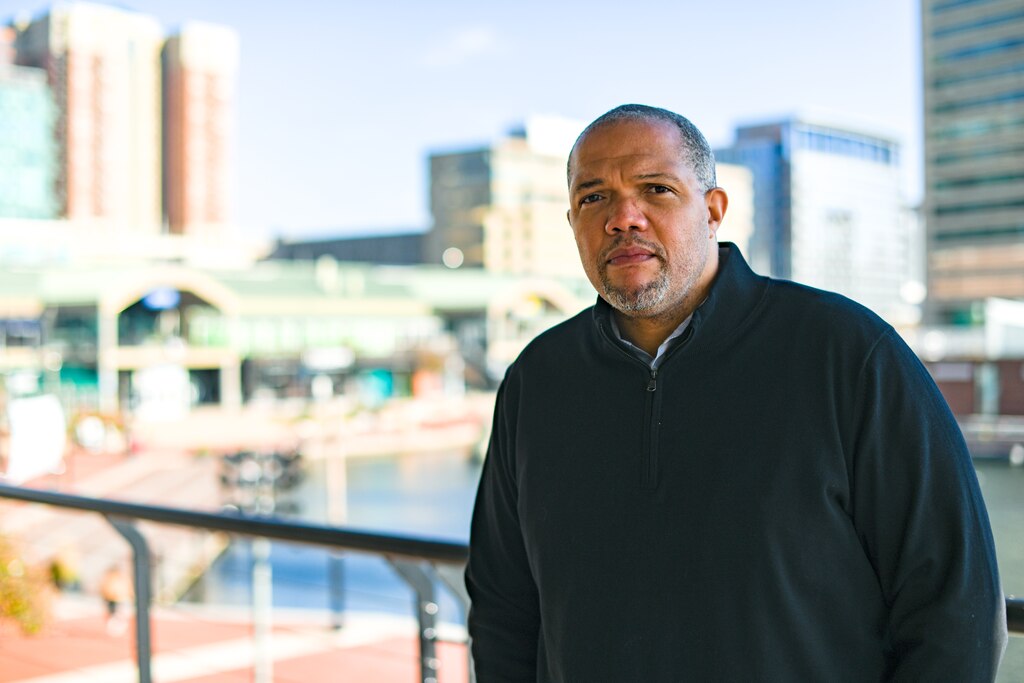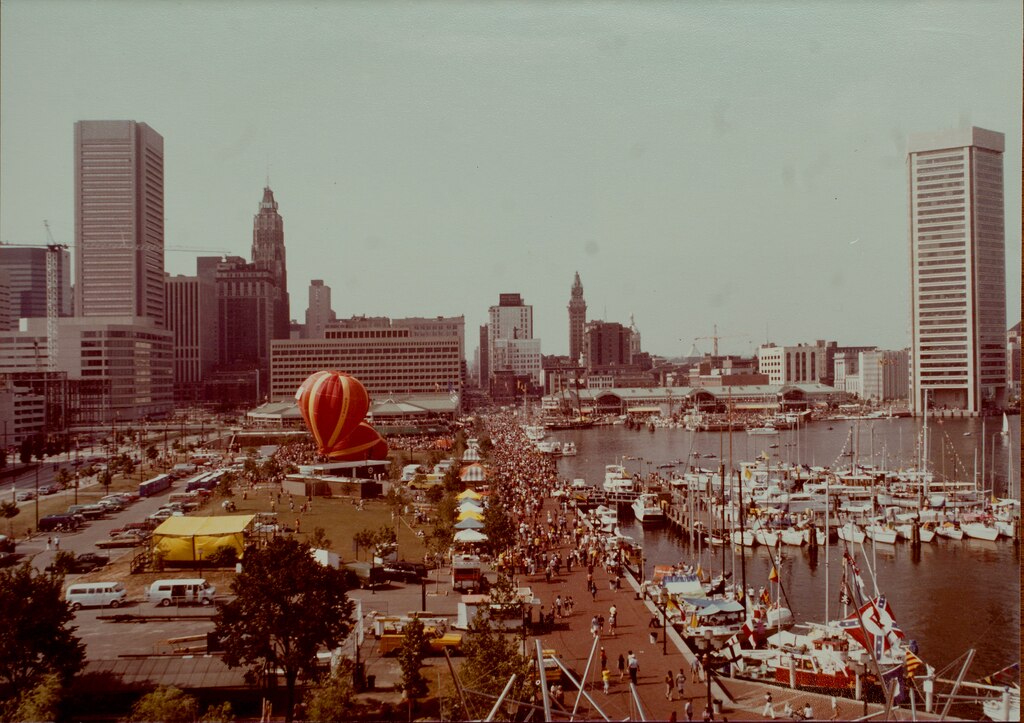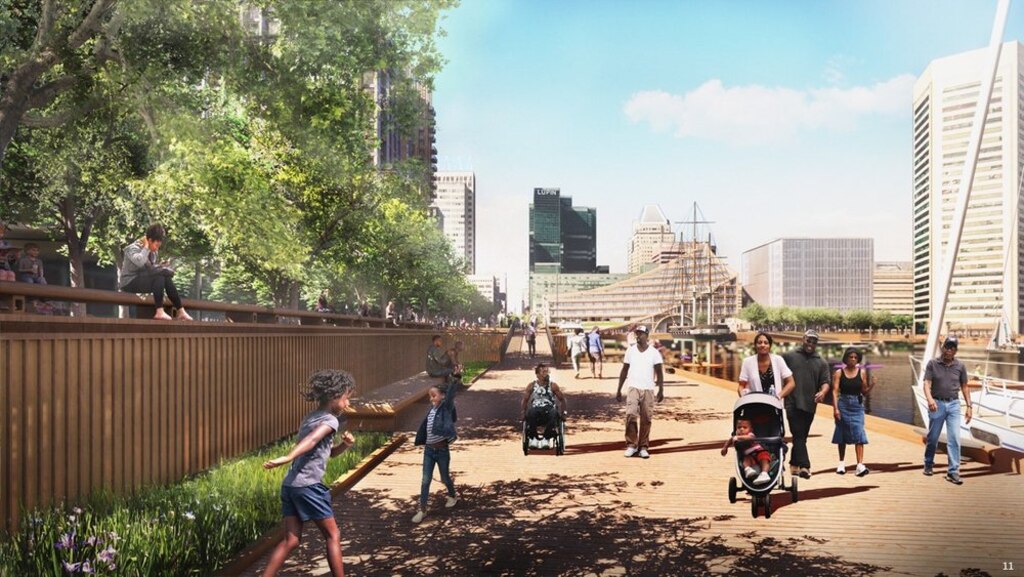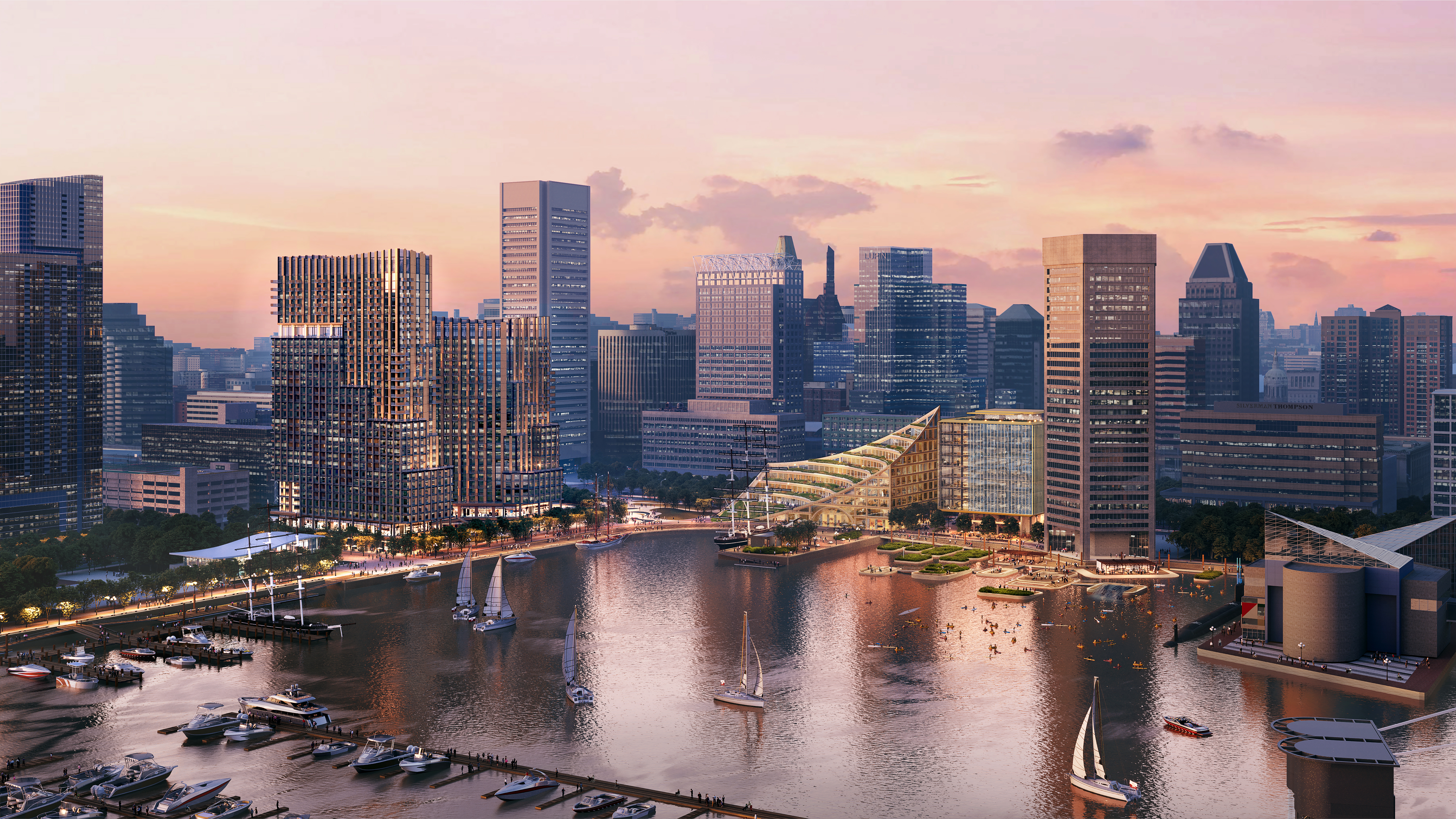P. David Bramble doesn’t want to mess this up.
The developer and West Baltimore native controls the city’s most intriguing piece of real estate: Harborplace.
The Inner Harbor’s dilapidated pavilions with green roofs are the result of a controversial bargain struck nearly five decades ago. Under a plan approved by voters, the city ceded public land to a private developer. In return, Baltimore got a dazzling festival marketplace on a waterfront promenade a block away from the central business district.
Harborplace was a sensation, drawing millions of visitors, but over time it lost its luster, traded hands and fell into disrepair. Last June, an LLC created by Bramble bought Harborplace for nearly $83 million after its previous owner defaulted on a loan and the property came under the control of a court-appointed receiver, records show. He beat other developers vying for the project.
This story is part of a deep dive into the future of Harborplace
Today, Bramble — more than any other individual — controls the fate of the Inner Harbor, a space beloved by people across the region and the closest thing Baltimore has to a public square.
It’s a once-in-a-lifetime opportunity for a hometown developer who grew up in the heyday of Harborplace, but in Bramble’s telling, he didn’t set out to buy it.
Read More
It started with a parking lot
The story begins across the street at 300 E. Pratt St., a parking lot where the Baltimore News American building once stood.
In January 2020, Bramble unveiled plans to build on that land a 40-story mixed-use tower with 200,000 square feet of office space. It would be one of the city’s tallest buildings.
“The location is key,” Bramble told The Baltimore Sun in 2020. “We’ve got tenant interest and we have the ingredients at this time to make this happen.”
It didn’t happen.

In a January interview with The Banner, Bramble, the co-founder of MCB Real Estate, shed light on what was going on behind the scenes. According to Bramble, MCB couldn’t find an anchor tenant that would commit to leasing a large chunk of a building and make the project financially viable.
He was calling executives and pitching a gleaming office tower that could compete against new developments in neighborhoods like Harbor Point and Port Covington, but Bramble said no company wanted to move to downtown Baltimore, given the uncertain future of Harborplace.
The twin pavilions, once seen as the saviors of downtown, now seemed a symbol of how far downtown had fallen.
Harborplace opened in 1980 and was an early example of the festival marketplace, a concept popularized by the influential developer James Rouse, who founded the community of Columbia and popularized the enclosed shopping mall. A festival marketplace was a highly curated retail experience featuring small and large vendors and a variety of restaurants.
The attraction became a Baltimore landmark, but the crowds dwindled as more festival marketplaces — many developed by the Rouse Company — opened across the country.

The pavilions had already fallen into disrepair when a New York company, the Ashkenazy Acquisition Corp., scooped up Harborplace in 2012 for $98.5 million, or about $130 million in today’s dollars. Under Ashkenazy’s ownership, tenants left, storefronts went dark and the once-bustling pavilions became mostly vacant.
Then, in 2019, there was hope.
A subsidiary of Ashkenazy was sued for defaulting on the loan it used to purchase Harborplace, kicking off a legal process known as receivership. Suddenly, anyone could submit a bid to buy Harborplace.
A plan built on relationships
Bramble said he came to realize that Harborplace was the linchpin upon which all of downtown Baltimore turned. If Harborplace failed, downtown would fail, he said.
According to Bramble, it would take more than a fresh coat of paint on Harborplace to rejuvenate the area. Baltimore needed to completely reimagine its Inner Harbor, Bramble said, and that meant elected officials had to be on board.
Like many prominent developers, Bramble and his business partner, Peter Pinkard, have donated to political campaigns for years, sometimes giving the $6,000 maximum to candidates. LeLand Shelton, a registered lobbyist for MCB, was the campaign treasurer for Brandon Scott’s successful 2020 mayoral campaign. Since 2022, MCB and its affiliated companies have paid $66,723 to lobby city officials and $180,000 to lobby state officials, public records show.
But Bramble said he has something far more important than political donations or lobbyists: a good reputation. He’s built relationships with top leaders through his professional work as a developer and his personal life as a Baltimorean.
“I think it’s critical that I’m from Baltimore,” Bramble said. For years, city officials had chafed at Harborplace’s out-of-town ownership. Now, Bramble’s local connections are paying dividends.
At a press conference last fall, Scott said one of his first actions as mayor was directing his law department and the city’s development arm to ensure that a local developer bought Harborplace. When Bramble called him pitching a “crazy” idea to reimagine the Inner Harbor, Scott told the audience, it made sense to him.
A tentative deal to buy Harborplace was announced April 2022, and politicians rejoiced that a West Baltimore native with a track record for getting projects done would be in charge.
“Dave [Bramble] has my full support and the support of my entire administration as we breathe new life into this Baltimore landmark,” Scott told The Baltimore Sun at the time. “I’ve had the city solicitor working with him since the beginning of the receivership process and I remain committed to seeing this to fruition.”
Scott also asked the Baltimore Development Corp. and business leaders “to begin a conversation about what local developers would be interested in taking on a project this scale with the interests of all Baltimoreans at the center,” according to a statement from the mayor’s office.
“That resulted in MCB stepping forward to take on the project,” the statement said.
State and city lawmakers have long considered the Inner Harbor’s revitalization a key priority. The city awarded MCB $1 million to assist with pre-development costs. In the 2022 session, the General Assembly passed a bill pledging $67.5 million for improvements to the Inner Harbor promenade. State Sen. President Bill Ferguson, one of Maryland’s most powerful lawmakers, represents the district that includes Harborplace and presided over the legislature when it pledged that funding.
If there were any qualms about Bramble’s capability to deliver, no official with a stake in the Inner Harbor — either city or state — discussed them publicly, and every vote in the approval process so far has passed with little dissent. If anything, local leaders moved in lockstep to get the aging property into Bramble’s hands.
That fall, the mayor and City Council as well as representatives from multiple civic and quasi-governmental organizations wrote letters urging a Baltimore Circuit Court judge to approve the sale of Harborplace, using identical language to praise Bramble.
Other developers had submitted bids for Harborplace, but Ian V. Lagowitz, principal of the court-appointed receiver, said in an email to The Banner that “no other potential purchaser offered terms even remotely equal to or better than the agreement reached with MCB.”
Publicly available documents do not say how many other developers submitted bids for Harborplace or what they proposed. In receivership cases, the highest bidder typically wins out.
After a judge approved the deal in December 2022, the sale closed the following June.
‘Let the chips fall’
After months of anticipation, Bramble unveiled the designs for a new Inner Harbor at an October press conference. He was flanked by Scott, Ferguson, Gov. Wes Moore and other politicians.
The developer wanted to demolish the Harborplace pavilions, which, at two stories tall, contain 150,000 square feet. MCB would then construct five buildings, including three commercial buildings that would total more than 400,000 square feet. One structure, called “The Sail,” would feature a curved roof with a park on top that would be open to the public.

The company also proposed building two residential towers in a “step-down” design, stretching 32 and 25 stories high, and containing as many as 900 units total.
The plans would create more space for pedestrians and cyclists by reducing car lanes along Pratt and Light streets — two of the busiest thoroughfares in Baltimore — and eliminating a spur that separates McKeldin Plaza from the Inner Harbor promenade. MCB estimated that the total redevelopment plans would cost at least $900 million, with about $400 million coming from taxpayers in a hypothetical mix of state and federal funds that have yet to be fully secured.
Speaking at the October press conference, Ferguson said Bramble’s proposed redevelopment “will be the ignition to light the revolution here in Maryland.”
According to Bramble and MCB, the designs were based on a massive amount of public input solicited both online and during in-person community meetings throughout the city. But he also knew the plans would face pushback.
Behind the scenes, Bramble hired Alexandra Hughes, a longtime political operative in Annapolis, to handle public relations. According to briefing documents obtained by The Baltimore Banner in a public records request, Hughes identified several controversial points ahead of the plan’s public release:
Why spend so much public money on a single project in Baltimore instead of other areas in Maryland? Does the project need apartments? And will they be priced for the average Baltimorean? Can this project attract enough retailers? Or would it just cannibalize retail from other areas of the city?
While elected officials have almost universally endorsed Bramble’s vision, residents raised many of these concerns, both online and in person.
A panel of local architects roasted the designs in November. A long line of residents testified at a planning commission meeting in December and a City Council hearing in February. A hodgepodge group of Baltimoreans has formed the Inner Harbor Coalition to oppose MCB’s plan.
At a press conference hosted by the coalition last month, Thiru Vignarajah, a Democratic candidate for mayor, said if he was elected, his administration would refuse to issue permits for MCB’s development.
“We need to have a conversation led by the community, not done in private and led by developers, about what we’re going to do with this most precious space,” Vignarajah said.
It’s a common refrain from critics, who say the process moved too fast and without enough pushback from elected leaders.
“This is too important decision for the city to have it made by the whims of a single person,” Jimmy Rouse, the son of the late James Rouse, wrote in a Baltimore Sun guest commentary in October. He argued that his father’s pavilions should not be torn down until a “fully financed replacement” wins public approval, and warned that Harborplace could meet the same fate as the Morris Mechanic Theater, torn down a decade ago in the name of redevelopment and now an empty lot.
But Bramble said criticism like this stems from a fundamental misunderstanding. With Harborplace in receivership, anyone, anywhere could have bought the aging pavilions.
He only did what his critics could not — or would not — do, he said. Instead of complaining, he acted.
“We are the ones who wrote checks,” Bramble said, noting that his firm stands to lose millions of dollars each year until Harborplace gets rebuilt.

The City Council passed three bills Monday night amending and loosening different restrictions that affect Bramble’s proposed redevelopment of Harborplace. The bills sailed through the city’s legislative process, facing relatively little pushback from council members, who have overwhelmingly voted in favor of the proposals.
Now, it’s up to voters.
This November, Baltimore residents will answer a ballot question that is key to Bramble’s plans: whether to amend the city charter to allow residences at the Inner Harbor.
To Bramble, it’s the ultimate litmus test for his re-imagining of Harborplace.
“Let the chips fall where they may,” he said.






Comments
Welcome to The Banner's subscriber-only commenting community. Please review our community guidelines.